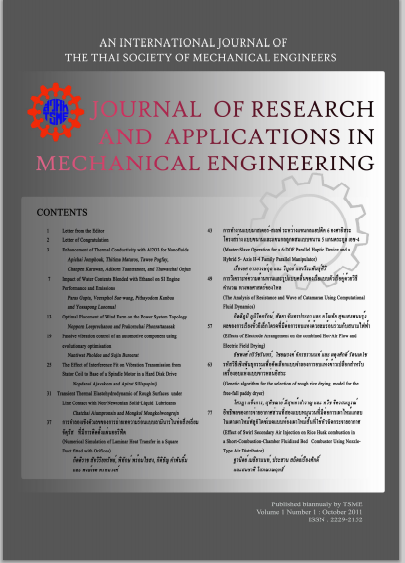Impact of water contents blended with ethanol on si engine performance and emissions
Main Article Content
Abstract
Recently, the oil crisis and energy security have become the serious concern all over the world. Ethanol, one of the alternative fuels for SI engine seems to have the potential for replacing the conventional fuels such as gasoline. However, the process of removing water contents from hydrous ethanol to make it anhydrous is a very costly operation. In order to have the economical advantage, the use of ethanol with water content can be seen as an interesting choice as a fuel in SI engines. Therefore, this work aims to investigate the effects of water contents blended with ethanol on thermal efficiency and emissions of SI engine. The 125-cc SI engine is used for the experiments. Tests are run at constant engine speed and stoichiometric air fuel ratio. The results show an increase in the thermal efficiency for hydrous ethanol having more than 10% water content. The bsfc value is increased on increasing water content. The NOx produced by hydrous ethanol is very low. The total unburned Water Contenthydrocarbons (THC) and the CO emissions are increased on water addition but even after the addition of 20% water by volume they are found lower than those of gasoline. So it proposes a solution for the fuel which satisfies the current environmental concerns and helps in improving the fuel economy.
Article Details
This work is licensed under a Creative Commons Attribution-NonCommercial-ShareAlike 4.0 International License.
References
[2] Associação Nacional dos Fabricantesmde Veículos Automotores- ANFAVEA. 2009. Brazilian Automotive Industry Yearbook 2009, Chapter 2 Vehicles-production, domestic sales
and exports. (cited 12 Sep 2010). Available from : URL: http://www.anfavea.com.br/anuario2009/-capitulo2a.pdf.
[3] Costa, R.C., Sodre, J.R., 2009. Hydrous ethanol vs. gasolineethanol blend: Engine performance and emissions. Fuel, Vol. 89, No. 2, pp. 287-293.
[4] Kortba, R., 2008. Testing the Water. Ethanol Producer Magazine. (cited 12 Sep 2010). Available from : URL: http://www.ethanolproducer.com/article.jsp?article_id=3981&q=&
page=1.
[5] Jager, D.E., Visser R., 2007. Hydrous Ethanol: Cheap and Sustainable. In: Proceedings of the Connecting Clean Mobility Conference, Amhem, Netherlands.
[6] Clemente, R.C., Werninghaus, E., Coelho, E.P.D., Ferraz, L.A.S., 2001. Development of an internal combustion alcohol fueled engine. SAE Paper No 2001-01-3917.
[7] Olberding, J., Beyerlein, D.C.S., Steciak, J., Cherry, M., 2005. Dynamometer testing of an ethanol–water fueled transit van. SAE Paper No 2005-01-3706.
[8] Li, L., Liu, Z., Wang, H., Deng, B., Xiao, Z., Wang, Z., Gong, C., Su, Y., 2003. Combustion and emission of ethanol fuel (E100) in small SI engine. SAE Paper No. 2003-01-3262.
[9] Christensen, M., Johansson, B., 1999. Homogenous charge compression ignition with water injection. SAE Paper No. 1999-01-0182.
[10] Amaral, R.A., 2000. Influence of engine geometric and operating parameters on aldehyde emissions from an ethanol fuelled vehicle. M.Sc. dissertation, Brazil, Pontifical Catholic
University of Minas Gerais.
[11] Takashi, H., Kimitoshi, T., 2006. Laminar flame speed of ethanol, n-heptane, iso-octane fuel mixtures. In: Proceedings of the FISITA 2006 Student Congress, Yokohama, Japan.
[12] Kremer, F.G., Fachetti, A., 2000. Alcohol as automotive fuel– Brazilian experience. SAE Paper No. 2000-01-1965.
[13] Park, C., Choi, Y., Kim, C., Oh, S., Lim, G. Moriyoshi, Y., 2010. Performance and exhaust emission characteristics of a spark ignition engine using ethanol and ethanol-reformed gas. Fuel, Vol. 89, No. 8, pp. 2118–2125.



